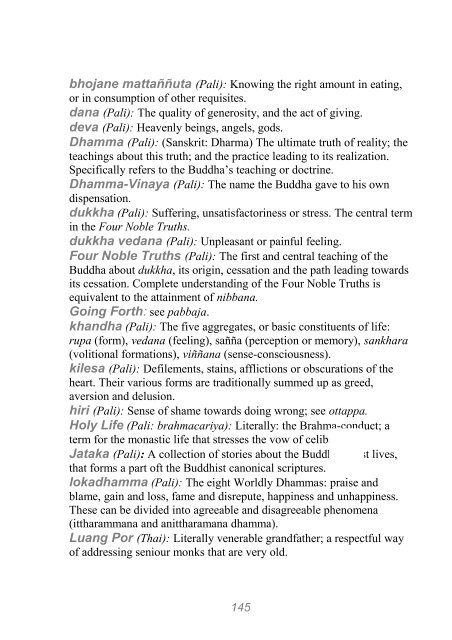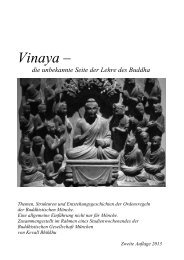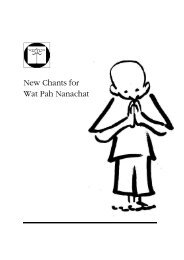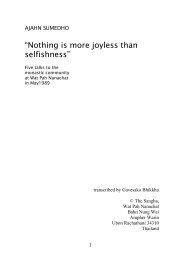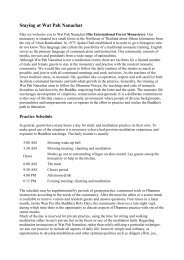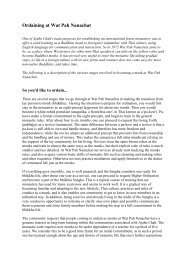Luang Por Liem: The Ways of the Peaceful - Wat Pah Nanachat
Luang Por Liem: The Ways of the Peaceful - Wat Pah Nanachat
Luang Por Liem: The Ways of the Peaceful - Wat Pah Nanachat
You also want an ePaper? Increase the reach of your titles
YUMPU automatically turns print PDFs into web optimized ePapers that Google loves.
hojane mattaññuta (Pali): Knowing <strong>the</strong> right amount in eating,<br />
or in consumption <strong>of</strong> o<strong>the</strong>r requisites.<br />
dana (Pali): <strong>The</strong> quality <strong>of</strong> generosity, and <strong>the</strong> act <strong>of</strong> giving.<br />
deva (Pali): Heavenly beings, angels, gods.<br />
Dhamma (Pali): (Sanskrit: Dharma) <strong>The</strong> ultimate truth <strong>of</strong> reality; <strong>the</strong><br />
teachings about this truth; and <strong>the</strong> practice leading to its realization.<br />
Specifically refers to <strong>the</strong> Buddha’s teaching or doctrine.<br />
Dhamma-Vinaya (Pali): <strong>The</strong> name <strong>the</strong> Buddha gave to his own<br />
dispensation.<br />
dukkha (Pali): Suffering, unsatisfactoriness or stress. <strong>The</strong> central term<br />
in <strong>the</strong> Four Noble Truths.<br />
dukkha vedana (Pali): Unpleasant or painful feeling.<br />
Four Noble Truths (Pali): <strong>The</strong> first and central teaching <strong>of</strong> <strong>the</strong><br />
Buddha about dukkha, its origin, cessation and <strong>the</strong> path leading towards<br />
its cessation. Complete understanding <strong>of</strong> <strong>the</strong> Four Noble Truths is<br />
equivalent to <strong>the</strong> attainment <strong>of</strong> nibbana.<br />
Going Forth: see pabbaja.<br />
khandha (Pali): <strong>The</strong> five aggregates, or basic constituents <strong>of</strong> life:<br />
rupa (form), vedana (feeling), sañña (perception or memory), sankhara<br />
(volitional formations), viññana (sense-consciousness).<br />
kilesa (Pali): Defilements, stains, afflictions or obscurations <strong>of</strong> <strong>the</strong><br />
heart. <strong>The</strong>ir various forms are traditionally summed up as greed,<br />
aversion and delusion.<br />
hiri (Pali): Sense <strong>of</strong> shame towards doing wrong; see ottappa.<br />
Holy Life (Pali: brahmacariya): Literally: <strong>the</strong> Brahma-conduct; a<br />
term for <strong>the</strong> monastic life that stresses <strong>the</strong> vow <strong>of</strong> celibacy.<br />
Jataka (Pali): A collection <strong>of</strong> stories about <strong>the</strong> Buddha’s past lives,<br />
that forms a part <strong>of</strong>t <strong>the</strong> Buddhist canonical scriptures.<br />
lokadhamma (Pali): <strong>The</strong> eight Worldly Dhammas: praise and<br />
blame, gain and loss, fame and disrepute, happiness and unhappiness.<br />
<strong>The</strong>se can be divided into agreeable and disagreeable phenomena<br />
(ittharammana and anittharamana dhamma).<br />
<strong>Luang</strong> <strong>Por</strong> (Thai): Literally venerable grandfa<strong>the</strong>r; a respectful way<br />
<strong>of</strong> addressing seniour monks that are very old.<br />
145


